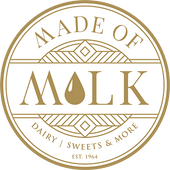The Role of Dairy in Indian Culinary Traditions
Dairy has long been an integral part of Indian culinary traditions, enriching the flavors, textures, and nutritional value of the country's diverse cuisine. Across the length and breadth of India, dairy products play a pivotal role in daily meals, festive feasts, and religious offerings. The journey of dairy in Indian kitchens is deeply intertwined with the nation’s cultural and agricultural roots, making it an indispensable part of Indian gastronomy.
A Legacy of Milk and its Derivatives
Milk is often referred to as “amrit” (nectar) in Indian culture, symbolizing purity and nourishment. From cow milk and buffalo milk to their myriad derivatives, dairy products are celebrated for their versatility and health benefits.
Products like whole milk, skim milk, and raw milk form the foundation for countless recipes, while specialized derivatives such as curd, ghee, and paneer have become staples. The nutritional richness of whole milk is widely acknowledged, offering essential vitamins and minerals that are key to health and vitality.
Dairy Products in Everyday Meals
1. Milk:
Milk is not just a beverage in Indian households; it’s a morning ritual. Whether consumed warm, flavored with turmeric or cardamom, or used as a base for tea, milk holds a special place in daily routines. Its variants, such as whole milk nutrition and skim milk, cater to different dietary needs.
2. Curd (Yogurt):
Curd is indispensable in Indian cuisine. Whether served plain, as sweet curd, or as a base for cooling dishes like raita, curd enhances digestion and balances spicy flavors. Modern adaptations, such as Greek yogurt, add a protein-rich twist to traditional meals, with benefits highlighted in Greek yogurt protein and Greek yogurt nutrition.
3. Paneer (Cottage Cheese):
Paneer, or cottage cheese, is a star ingredient in vegetarian dishes like palak paneer and paneer tikka. Innovations such as low-fat, high-protein paneer are gaining popularity among health-conscious consumers.
4. Ghee (Clarified Butter):
No Indian meal is complete without the aroma of ghee. Known for its rich flavor and nutritional benefits, ghee is used in cooking, drizzled over rice, or added to sweets.
5. Butter and Cream:
Traditional Indian dishes often use makhan (white butter) and malai (cream) to achieve creamy textures and luxurious flavors.
Sweets: A Celebration of Dairy
India’s world of sweets is a testament to the creative use of dairy. Festive occasions, weddings, and even daily life are enriched with an array of dairy-based sweets that reflect regional diversity and culinary ingenuity.
1. Khoa/Mawa:
Condensed milk solids, or khoa, are the foundation for many Indian sweets. Delicacies like milk cake, kesar mawa peda, and malai cham cham showcase the versatility of this ingredient.
2. Rasgulla and Rasmalai:
Soft, spongy balls of chhena (fresh cottage cheese) soaked in sugar syrup or flavored milk are beloved across the country. The creamy rasmalai highlights the perfect marriage of condensed milk and delicate spices.
3. Ladoos and Barfis:
Whether it’s the sugar-free makhana dry fruit ladoo or rose barfi, Indian sweets have evolved to cater to modern preferences while preserving traditional flavors.
4. Shrikhand and Mishti Doi:
These yogurt-based desserts, including elaichi shrikhand and mango shrikhand, are celebrated for their creamy textures and refreshing flavors. Made with thickened, sweetened yogurt, they offer a delightful balance of nutrition and indulgence.
The Cultural and Religious Significance of Dairy
Dairy products are deeply embedded in Indian rituals and traditions. Milk and ghee are considered sacred, often used in religious ceremonies and offerings.
-
Milk as an Offering: Milk is offered to deities during rituals, symbolizing purity and devotion.
-
Ghee in Rituals: Ghee lamps are lit in temples and homes, signifying prosperity and divinity.
-
Prasadam: Dairy-based sweets like gulab jamun, kesar kaju katli, and rajbhog are frequently distributed as prasadam (blessed food) in religious gatherings.
Dairy in Beverages
Indian beverages, from traditional lassis to modern smoothies, showcase the versatility of dairy:
-
Lassi: Variants like malai lassi, kesar & nuts lassi, and mango lassi are popular for their refreshing and energizing qualities.
-
Masala Chaas: This spiced buttermilk is a cooling drink for hot summer days.
-
Masala Milk: Flavored with saffron and spices, masala milk is a favorite bedtime drink.
Made of Milk: Preserving Tradition with Modern Excellence
Brands like Made of Milk bridge the gap between tradition and modernity by offering high-quality dairy products crafted with love and care. By sourcing milk from a single farm in the lush greenery of Lonavala, Made of Milk ensures purity and sustainability in every product.
Their diverse offerings include traditional staples like cow ghee, buffalo milk, and natural yogurt, alongside innovative products like sugar-free anjeer dry fruits and too good yogurt. Their commitment to quality reflects the enduring principles of Indian dairy craftsmanship.
The Nutritional Legacy of Dairy
Dairy products are celebrated not just for their taste but also for their nutritional benefits. Rich in calcium, protein, and essential vitamins, dairy supports bone health, muscle repair, and overall well-being.
-
Greek Yogurt Protein: A modern favorite for fitness enthusiasts.
-
Whole Milk Nutrition: A source of essential fats and vitamins for growing children.
-
Low-Fat Paneer: Perfect for weight management without compromising on protein.
Conclusion
Dairy is the heart of Indian culinary traditions, weaving together flavors, culture, and nutrition. From the creamy richness of malai to the tangy freshness of curd, dairy products continue to inspire chefs and delight palates across generations. Brands like Made of Milk honor this legacy, blending tradition with innovation to deliver the best of India’s dairy heritage. As we savor a bite of kaju katli or sip on a chilled glass of lassi, we celebrate not just food but a timeless connection to our roots.
